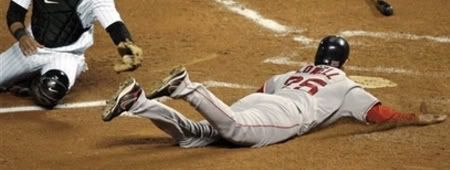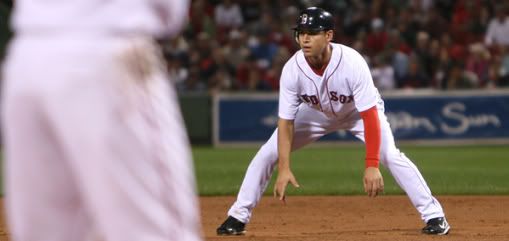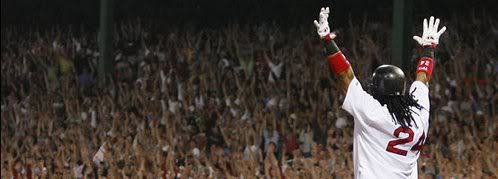Since the Red Sox became involved in talks regarding Johan Santana, more than a month ago, they haven't made a single move. Not only do Santana talks require quite a bit of the team's attention, but it prevents the Red Sox from discussing trades involving many players such as Coco Crisp, Jon Lester, Jed Lowrie and Justin Masterson.
When the new year comes in a couple days, and the Twins return to the negotiating table, the Red Sox will have some decisions to make. The best possible outcome of the new year, would be a quick resolution of the Santana talks, in which Santana is dealt to either the Red Sox or the Mets. That way the Red Sox could focus on filling up the remaining holes in their roster.
If, however, Santana talks continue to be drawn out for weeks to come, the Red Sox options for their remaining needs of a backup catcher, backup corner infielder and backup outfielder may be somewhat limited. And the Red Sox may have to settle with the bullpen they have, rather than adding some additional insurance and depth to their relief staff.
Backup Catcher - If the season began today, the Red Sox would most likely go with minor leaguer Dusty Brown (
career stats) as their backup catcher. Brown hit .268/.344/.453 last year at the Double-A level, and is an excellent defensive catcher with a good arm. But he's yet to play more than eight games at the Triple-A level, and the Red Sox may prefer a more proven option.

If the Red Sox retain Coco Crisp, they could deal him for Rangers backup catcher Gerald Laird. Both teams expressed interest in such a trade before the Santana talk began. Laird is another stellar defensive catcher with a great arm. But unlike Brown, he projects to eventually become an everyday catcher, which would make him more appealing to the Red Sox.
Laird hit .310/.380/.562 at the Triple-A level in 2005, but he's yet to come into his own as a major league offensive threat. In 2006, Laird had a solid line of .296/.332/.473 but last year he had a bizarre off year. Not only did he not hit, but he didn't field either, having the lowest fielding percentage of all catchers in 2007.
If the Red Sox trade Crisp in a Santana deal. They could either fall back on a free agent such as Doug Mirabelli or the more expensive Johnny Estrada. Or the Red Sox could attempt a trade for someone like Michael Barrett, who's stock has taken a dip.
Backup Corner Infielder - The only player I know of that the Red Sox have made a formal offer to is Ryan Klesko. Klesko would be a good hitting backup and would provide a left-handed bat off the bench to oppose the right-handed bats of Kevin Youkilis and Mike Lowell. Defensively, however, Klesko is challenged.
If the Red Sox prefer a more defensive minded option, they could go with free agent Jeff Cirillo. Cirillo is a lefty killer who plays both corner infield spots well. He also hit .340/.375/.500 with runners in scoring position last year, something which could make him a valuable option off the bench for both defense and offense.
Backup Outfielder - Whether or not the Red Sox acquire Santana, they're going to deal Crisp somewhere else. Ellsbury is their center fielder of the present and future and Crisp has said that he won't take a backup role. If Crisp is dealt, Bobby Kielty has said that he'd return to the Red Sox as a free agent. Kielty could provide an alternative to Drew when the Red Sox face lefties, but Kielty didn't hit lefties very well last year.
The Red Sox may prefer the cheaper option of promoting from within. Brandon Moss could be a valuable backup outfielder. He has above average speed for a corner outfielder and has the arm to play even right field. And offensively, Moss has a steady, effective approach at the plate. He hit .282/.363/.471 at Triple-A last year, and .280/.379/.440 in 15 games with the Red Sox.
I like Moss a lot. Even if he never reaches his full potential as a power hitting corner outfielder, I still like his steady, solid approach to the game. He can field, he can throw, he's a patient hitter, and he can hit both lefties and righties. He strikes out a bit too much, but he is only 24 and once he manages his strike out totals, his offensive output could increase quite a bit. I'd like to see what he could do in more time at the major league level.
That covers the major needs of the Red Sox going into 2008. As stated earlier, they may also look to add another reliever. That's more of a luxury than a necessity, however, with Okajima and Delcarmen already on the roster. It's easy to get excited about the Red Sox with all their pitching depth, offense, and good young prospects.
But before getting too excited, you have to remember that there are important spots on the roster which the Red Sox have yet to fill. Once they have found a backup catcher, infielder and outfielder, I'll be able to rest more easily. Although, with the Red Sox great farm system, I have a feeling many of these positions will be won in Spring Training, with Red Sox minor leaguers providing firm competition to any free agents who may be brought in.
 The polls are now closed and well over 100 people have spoken. The second most popular selection in the poll was that neither Red Sox package of prospects was worth giving up for Santana. But 26 more voters (and 50% of the voters overall) said that they'd give up the Lester, Lowrie package for Santana. Only 9% of voters, however, were willing to give up Ellsbury and Lowrie in a package for Santana.
The polls are now closed and well over 100 people have spoken. The second most popular selection in the poll was that neither Red Sox package of prospects was worth giving up for Santana. But 26 more voters (and 50% of the voters overall) said that they'd give up the Lester, Lowrie package for Santana. Only 9% of voters, however, were willing to give up Ellsbury and Lowrie in a package for Santana.

























